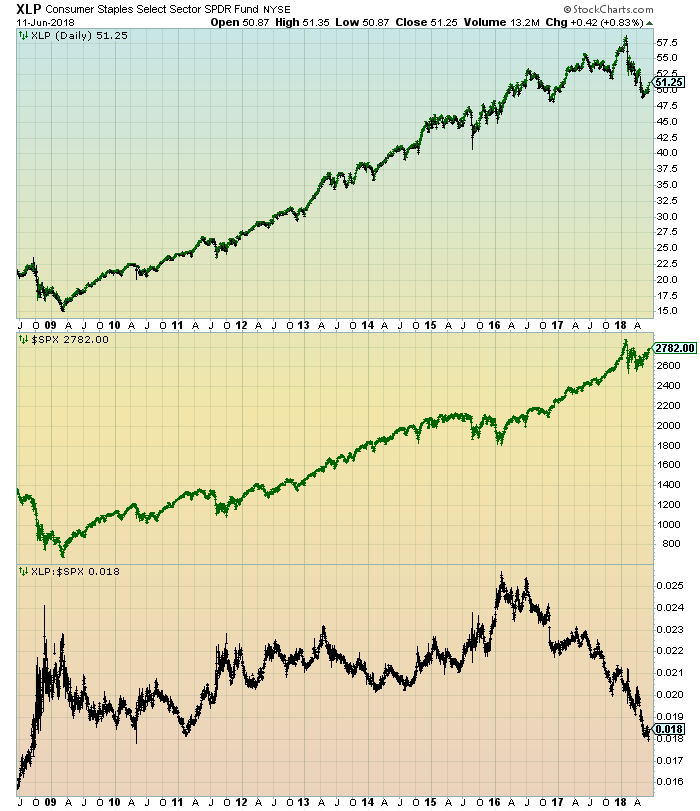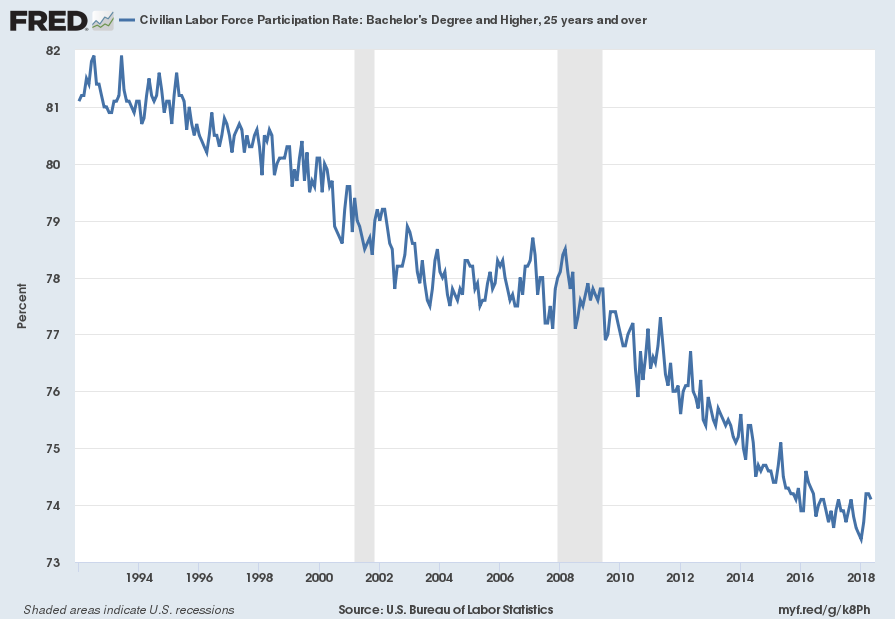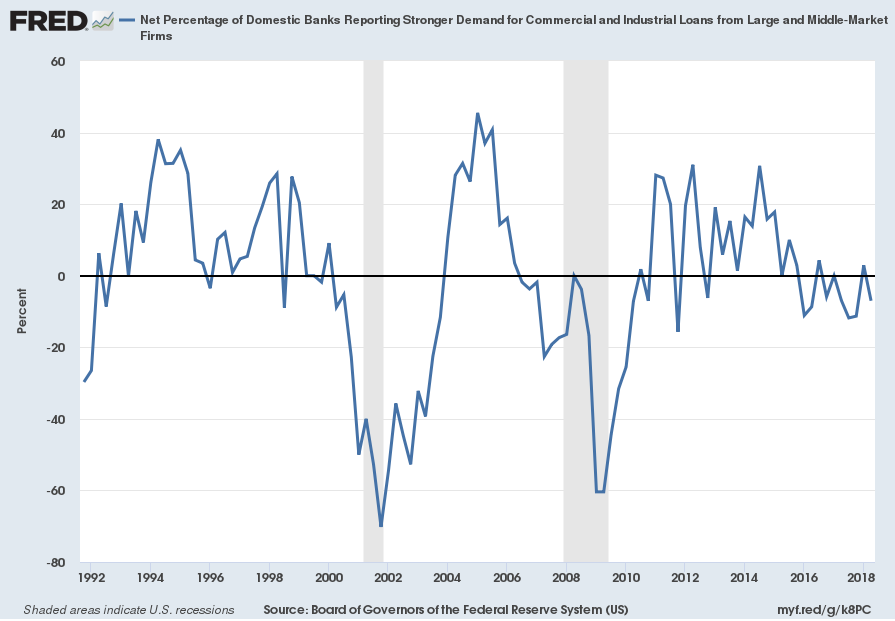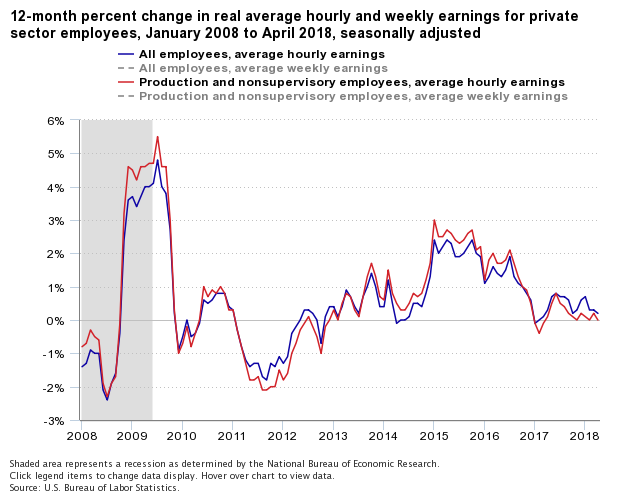U.S. Economic Indicators
Throughout this site there are many discussions of economic indicators. At this time, the readings of various indicators are especially notable. This post is the latest in a series of posts indicating U.S. economic weakness or a notably low growth rate.
While many U.S. economic indicators – including GDP – are indicating economic growth, others depict (or imply) various degrees of weak growth or economic contraction. As seen in the June 2018 Wall Street Journal Economic Forecast Survey the consensus (average estimate) among various economists is for 2.9% GDP growth in 2018. However, there are other broad-based economic indicators that seem to imply a weaker growth rate.
As well, it should be remembered that GDP figures can be (substantially) revised.
Charts Indicating U.S. Economic Weakness
Below are a small sampling of charts that depict weak growth or contraction, and a brief comment for each:
Total Federal Receipts
“Total Federal Receipts” growth continues to be intermittent in nature since 2015. As well, the level of growth does not seem congruent to the (recent) levels of economic growth as seen in aggregate measures such as Real GDP.
“Total Federal Receipts” through May had a last value of $217,075 Million. Shown below is displayed on a “Percent Change From Year Ago” basis with value -9.7%, last updated June 12, 2018:
source: U.S. Department of the Treasury. Fiscal Service, Total Federal Receipts [MTSR133FMS], retrieved from FRED, Federal Reserve Bank of St. Louis, accessed June 13, 2018:
__
Underperformance Of Consumer Staples Stocks
In the March 23, 2017 post (“‘Hidden’ Weakness In Consumer Spending?“) I wrote of various indications that consumer spending may be (substantially) less than what is depicted by various mainstream indicators, including overall retail sales.
One recent development that appears to be a problematical aspect of consumer spending is the performance of the consumer staples stocks. As one can see in the chart below, there has been a marked relative weakness in these stocks (with the XLP serving as a proxy). The chart shows a 10-year daily depiction of the XLP (top plot), the S&P500 (middle plot) and XLP:S&P500 ratio (bottom plot.) While there can be various interpretations and reasons for this underperformance, it does appear to represent a “red flag” especially considering other problematical indications concerning consumer spending:
(click on chart to enlarge image)(chart courtesy of StockCharts.com; chart creation and annotation by the author)
__
Unemployment
I have written extensively concerning unemployment, as the current and future unemployment issue is of tremendous importance.
The consensus belief is that employment is robust, citing total nonfarm payroll growth and the current unemployment rate of 3.8%. However, my analyses continue to indicate that the conclusion that employment is strong is incorrect. While the unemployment rate indicates that unemployment is (very) low, closer examination indicates that this metric is, for a number of reasons, highly misleading.
My analyses indicate that the underlying dynamics of the unemployment situation remain exceedingly worrisome, especially with regard to the future. These dynamics are numerous and complex, and greatly lack recognition and understanding, especially as how from an “all-things-considered” standpoint they will evolve in an economic and societal manner. I have recently written of the current and future U.S. employment situation on the “U.S. Employment Trends” page.
While there are many charts that can be shown, one that depicts a worrisome trend is the Civilian Labor Force Participation Rate for those with a Bachelor’s Degree and Higher, 25 years and over. Among disconcerting aspects of this measure is the long-term (most notably the post-2009) trend, especially given this demographic segment.
The current value as of the June 1, 2018 update (reflecting data through the May employment report) is 74.1%:
source: U.S. Bureau of Labor Statistics, Civilian Labor Force Participation Rate: Bachelor’s Degree and Higher, 25 years and over [LNS11327662], retrieved from FRED, Federal Reserve Bank of St. Louis; accessed June 11, 2018:
__
Loan Demand And Related Measures
As seen in previous updates, various aspects of lending growth and related measures have shown a marked slowing in the growth rate. Here is a measure, Net Percentage of Domestic Banks Reporting Stronger Demand for Commercial and Industrial Loans from Large and Middle-Market Firms, that shows a decline:
source: Board of Governors of the Federal Reserve System (US), Net Percentage of Domestic Banks Reporting Stronger Demand for Commercial and Industrial Loans from Large and Middle-Market Firms [DRSDCILM], retrieved from FRED, Federal Reserve Bank of St. Louis; accessed June 11, 2018:
__
Wages And Earnings
The level and growth rates of wages and household earnings continues to be (highly) problematical. I have extensively discussed these worrisome trends in income and earnings.
As seen in many measures the problem is chronic (i.e long-term) in nature.
Shown below is a chart depicting the 12-month percent change in real average hourly and weekly earnings for private sector employees from January 2008 – April 2018. As seen in the chart, growth in this measure over the time period depicted has been intermittent, volatile, and, especially since 2017, weak:
source: Bureau of Labor Statistics, U.S. Department of Labor, The Economics Daily, Real average hourly earnings up 0.2 percent for all private employees from April 2017 to April 2018 on the Internet at https://www.bls.gov/opub/ted/2018/real-average-hourly-earnings-up-0-point-2-percent-for-all-private-employees-april-2017-to-april-2018.htm(visited June 11, 2018).
__
Other Indicators
As mentioned previously, many other indicators discussed on this site indicate economic weakness or economic contraction, if not outright (gravely) problematical economic conditions.
_____
The Special Note summarizes my overall thoughts about our economic situation
SPX at 2786.85 as this post is written





No comments:
Post a Comment